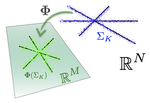compressive sensing
What can we learn from the Compressed Sensing theory?
Abstract: The recent theory of Compressed Sensing (CS) induces a revolution in the design of signal sensors and of imaging devices. By the advent of increased computing capabilities, along with recent theoretical and numerical breakthroughs in the fields of Image Processing, Sparse Signal Representations, Inverse Problem solving and Convex Optimization, the term Sensing is no more a synonym for readily rendering human readable signals.
Robust 1-Bit Compressive Sensing: How the Sign of Random Projections Distinguishes Sparse Vectors
Joint work with J. Laska, P. Boufounos, R. Baraniuk
Abstract: The Compressive Sensing (CS) framework aims to ease the burden on analog-to-digital converters (ADCs) by reducing the sampling rate required to acquire and stably recover sparse signals.
Robust 1-Bit Compressive Sensing: How the Sign of Random Projections Distinguishes Sparse Vectors
Joint work with J. Laska, P. Boufounos, and R. Baraniuk.
Some comments on Noiselets
Recently, a friend of mine asked me few questions about Noiselets for Compressed Sensing applications, i.e., in order to create efficient sensing matrices incoherent with signal which are sparse in the Haar/Daubechies wavelet basis.
New class of RIP matrices?
Wow, almost one year and half without any post here… Shame on me! I’ll try to be more productive with shorter posts now ;-)
I just found this interesting paper about concentration properties of submodular function (very common in “Graph Cut” methods for instance) on arxiv:

